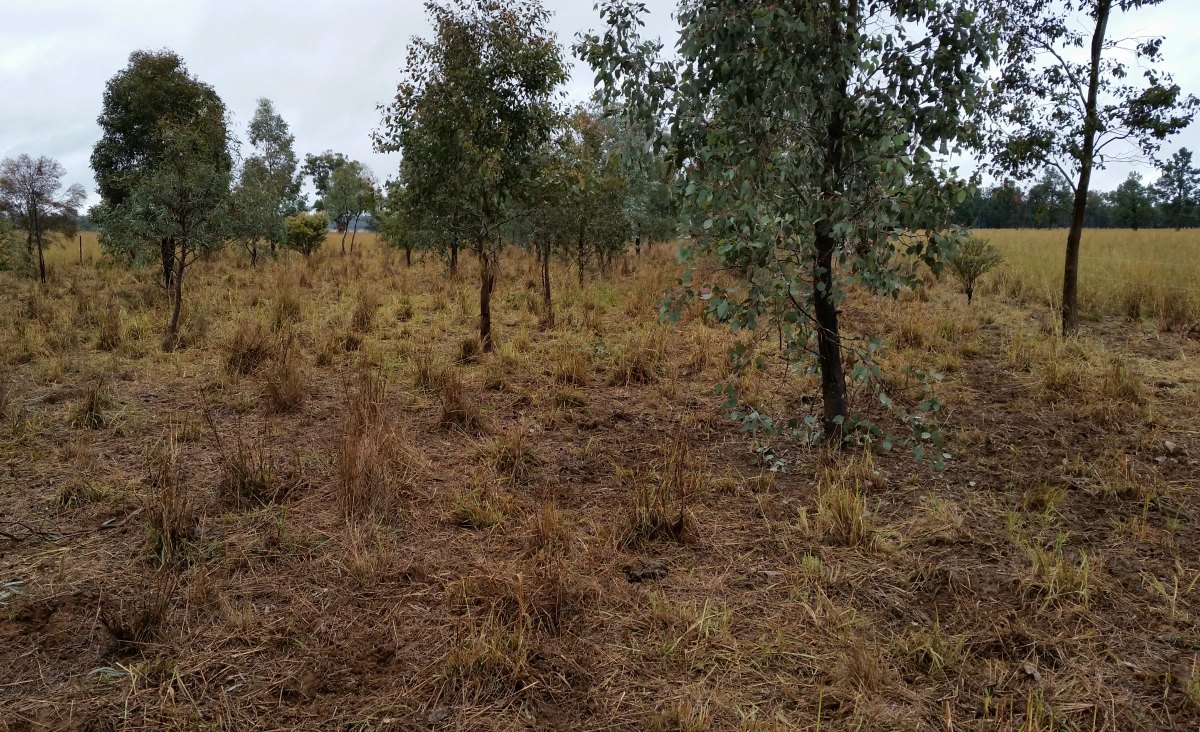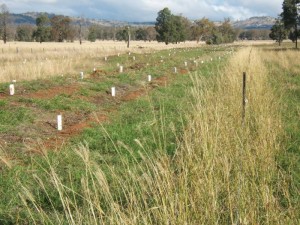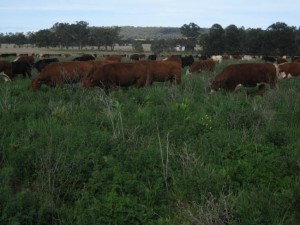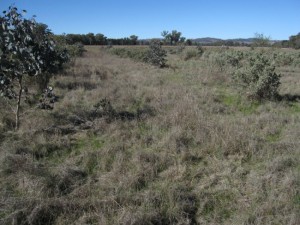If there is a consistent message coming out of regenerative agriculture practices of all kinds it is the need for soil biology, and for a diversity of this. We gain this from a diversity of species of plants, as well as animals.
I used to think about biodiversity as diversity in the soil, or in our pastures or of native fauna – all of which might have benefited and supported the production of one product from an area of land – be it beef, lamb, goats, wheat or corn. But of late, (as well as the wonderful benefits that biodiversity can offer to a current traditional production system), I have started to consider biodiversity from the point of view of the number of layers of productive biodiversity that we can have.
Productive biodiversity
We have planted a number of tree lanes on our farm over the years, to link remnant vegetation and to provide more biodiversity to our farm. These lanes are planted to native eucalypts and wattles, but they don’t provide any direct productivity to our business. After listening to and chatting with Mark Shephard (farmer and consultant of permaculture and agroforestry) at Acres, he made me think, why couldn’t we have some direct productivity (and direct monetary gain) coming from these tree lanes. [private]As well as doing their job of helping with soil and above ground biodiversity, being a haven for small birds and providing shade for stock, can’t a tree lane also provide cash flow?
Could we have some kind of nut or fruit tree? These could be for saleable production or even just for our own use? Better than buying them, and then I know how they are produced. Things like nuts could also provide a protein source if we ever introduce free range pigs to our farm. Could we grow some kind of brush that could be sold to florists to accompany cut flowers? (Remember twisted willows took off some years ago?)
Maybe it could be a mix of all of these. Would people pay to come and pick their own fruit and nuts? Now I know most of us don’t have the luxury of a market of several hundred thousand people at our doorstep, and there is extra work involved with such suggestions, but with farm businesses generally having such relative low return on equity when compared with other businesses, these questions are certainly worth thinking about.
The benefits of the biodiversity of trees
On our farm the tree lanes are interspersed across the farm, to fill in the less treed areas, but we still have many areas of open pasture. Mark Shephard spoke of alley cropping, where few of these large open pasture areas are left, but rather more intensely placed tree lanes or belts are grown with an annual crop or perennial pasture in between the high value trees. The annual crop or pasture provides income as the high value trees develop to full production. Now many of us are graziers and grain croppers and I imagine don’t want to become farmers of high value nut or fruit trees (and it may not suit your climate, your skill set or your personal likes), but I mention the alley cropping for a number of reasons.
The same underground benefits can be gained by increasing biodiversity with tree lanes – regardless of whether the trees are directly income producing or not – so why not at least consider planting something for direct income. The alley cropping that Mark spoke of reminds me of work done by the Engineered Woodlands Project on the tablelands of NSW, Australia. While this project did not look at income producing trees, (but rather native eucalypts, wattles and other native shrubs), it did highlight the impact of these trees on a number of things production related.
Pasture production
One of the engineered woodland sites (which is a similar layout idea to what Mark Shephard talked of – trees with areas in between that are a practical size for grazing or for working machinery) had pasture production monitored over the Spring time. Over double the pasture dry matter production was achieved in the tree influenced area, than in the open paddock area1. I’m sure this is something you would have subjectively noticed yourself at times.
Animal performance
Not only are there benefits to pasture production, and the resulting effects of this on animal performance but there are also other potential benefits to animal performance. In cooler regions such as the tablelands area, where the Engineered Woodlands project was carried out, wind chill factors can have a significant impact on animal production, and so too can overheating in summer.
Animals have a thermal neutral zone, which is a range of effective temperatures between which the animals’ efficiency of performance is maximised. A 20km/hr wind can push an air temperature of 8oC to -5oC2 – potentially pushing certain livestock classes out of their optimal production temperature range. Clearly, the shelter from trees belts will help with alleviating wind chill factors.
Conversely, heat can affect livestock performance as it can result in them limiting their intake under conditions that are too hot. Walt Davis (US grazier of holistic management and the biological approach) reports a 20oF (around 9oC) difference in the temperature on the back of a black coated cow that on a paler coated cow on a hot day3. Aside from the obvious questions about breed choice/coat colour in hot areas, this highlights the benefits that shade and tree lanes could have on animal production.
Root Shearing
Now the reason I mentioned Mark Shephard here was that he advocates the knifing alongside tree lanes once per year in order to shear off the tree roots in the shallower zone where the adjacent pasture and crop roots are also seeking moisture. This alleviates the competition between the tree and the smaller grass and forb species. Mark explained to me that this can be done really quite close to the tree with limited ill effect on the tree and a resulting better production around the treelane. Alley cropping, engineered woodlands, tree lanes – whatever the specific design or variation you may have (or plan) for trees on your farm, these all would lend themselves to having such root shearing done. Introducing the root shearing/cutting, may well make croppers consider the benefits of tree lanes for their cropping enterprises, once the root competition in alleviated.
Biodiversity for livestock nutrition
Hugh Lovell (consultant of fertility management and biodynamics) says that when we get up toward 50 plant species growing together, the need for any soil amendments is overcome – soil nutrition just takes care of itself. And it’s not just soil nutrition. When we have a wide variety of species, this will be a massive benefit to livestock health too. There are secondary compounds in plants that act like medicines to the livestock. Things like alkaloids, essential oils and tannins. And it is often plants that we might consider ‘weeds’ that have such great properties. Some prove effective against intestinal parasites, some help prevent or treat the discomfort and associated problems of bloat, some help with liver cleansing – and the list goes on. The beauty is that our livestock haven’t lost their intuition in knowing what to select from the pasture to improve their health or rectify their ailments. If livestock have access to a diversity of species, it means they can pick and choose their plants and their ‘medicines’.
Such secondary compounds that may prove beneficial to livestock are also present in trees and shrubs. You will often see livestock browsing trees for this reason. So, when tree lanes reach an appropriate level of maturity, give the livestock access to these areas.
So, adding a diversity of species in a tree lane or a hedge row, (whatever you want to call it in your part of the world), adds more diversity to an area. This will benefit the soil, whilst also providing a greater diversity for livestock to browse on. What are the typical livestock health problems in your area and what plants are associated with helping with this?
The ideas I have presented – about the biodiversity of species benefiting the whole system are some of the ideas based supoprting permaculture. I have however, taken some of the concepts and tried to make them doable for broadacres farmers and larger scale graziers (while still having relevance to smaller plot farmers).
Have you considered trees on your farm?
Do you have existing tree lanes that you might think differently about now?
How else might you add productive layers of biodiversity?
References
- Andrew, S. (2007) Engineered Woodlands – The Lakeview demonstration/trial site at Uralla. Landchat no 61. http://www.snelandcare.org.au/linkedfiles/EWArticleLandchat61.pdf
- Andrew, S. Direct contact, Biodiverstiy , Grazing and Soil Carbon Field Day.
- Davis, W. Direct communication, Acres Conference.





Thank you for the blog and Shane Andrews article.